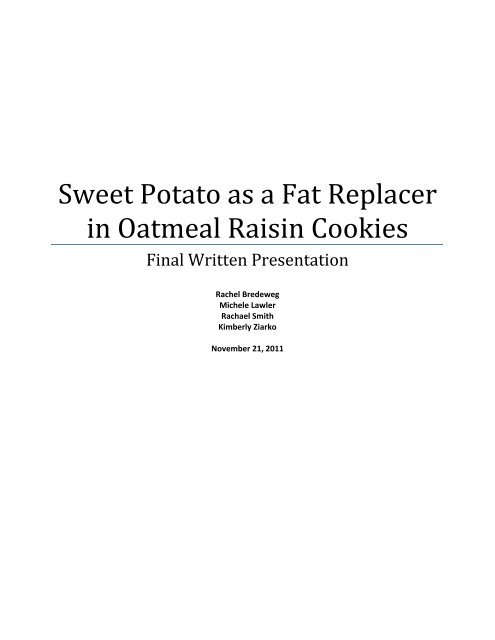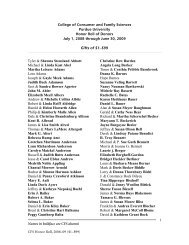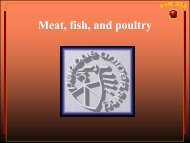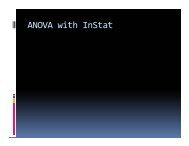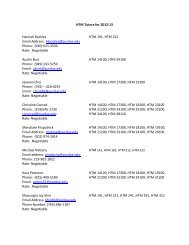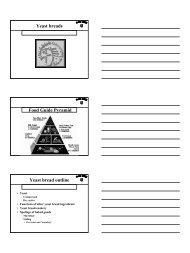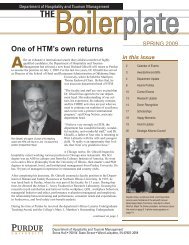Sweet Potato as a Fat Replacer in Oatmeal Raisin Cookies
Sweet Potato as a Fat Replacer in Oatmeal Raisin Cookies
Sweet Potato as a Fat Replacer in Oatmeal Raisin Cookies
You also want an ePaper? Increase the reach of your titles
YUMPU automatically turns print PDFs into web optimized ePapers that Google loves.
<strong>Sweet</strong> <strong>Potato</strong> <strong>as</strong> a <strong>Fat</strong> <strong>Replacer</strong><br />
<strong>in</strong> <strong>Oatmeal</strong> Rais<strong>in</strong> <strong>Cookies</strong><br />
F<strong>in</strong>al Written Presentation<br />
Rachel Bredeweg<br />
Michele Lawler<br />
Rachael Smith<br />
Kimberly Ziarko<br />
November 21, 2011
Abstract<br />
Creat<strong>in</strong>g healthier desserts and snacks is <strong>in</strong> high demand from consumers <strong>as</strong> obesity rates <strong>in</strong> the<br />
United States are on the rise. Substitut<strong>in</strong>g sweet potato for butter <strong>in</strong>to oatmeal rais<strong>in</strong> cookies w<strong>as</strong><br />
studied to see how replac<strong>in</strong>g butter <strong>in</strong> the recipe affected the color, texture, and t<strong>as</strong>te of the cookies<br />
compared to the normal oatmeal rais<strong>in</strong> cookie recipe. Variations of half‐fat replacement (50% fat<br />
replaced) and full‐fat replacement (100% fat replaced) were tested aga<strong>in</strong>st the control to determ<strong>in</strong>e<br />
which variable consumers would like most. Objective me<strong>as</strong>ures from the Hunter Colorimeter, Water<br />
Activity System, and Texture Analyzer were recorded <strong>as</strong> well <strong>as</strong> sensory me<strong>as</strong>ures from 30 panelists<br />
us<strong>in</strong>g a Hedonic scale. It w<strong>as</strong> found that the most preferred variable w<strong>as</strong> the cookie with half‐fat<br />
replacement.<br />
Introduction<br />
In the p<strong>as</strong>t decade, creat<strong>in</strong>g overall healthier desserts and snacks h<strong>as</strong> been a high consumer<br />
demand <strong>as</strong> the nation h<strong>as</strong> become more aware of our grow<strong>in</strong>g health issues. An estimated 32% of<br />
children and 66% of adults are overweight and obese, which h<strong>as</strong> been steadily <strong>in</strong>cre<strong>as</strong><strong>in</strong>g over the l<strong>as</strong>t<br />
thirty years (Lloyd‐Jones, 2010). This <strong>in</strong>cre<strong>as</strong>e <strong>in</strong> obesity h<strong>as</strong> also led to a higher prevalence <strong>in</strong> heart<br />
dise<strong>as</strong>e, diabetes, and other correlated health problems <strong>in</strong> recent years. For this re<strong>as</strong>on, produc<strong>in</strong>g more<br />
heart‐healthy food items h<strong>as</strong> been a major target <strong>in</strong> the food <strong>in</strong>dustry. One way to decre<strong>as</strong>e the dietary<br />
fat <strong>in</strong> foods is to substitute fat with a fat replacer to lower the amounts of saturated fats and trans‐fat<br />
that can lead to the grow<strong>in</strong>g obesity and health issues. One possible substitute that w<strong>as</strong> tested w<strong>as</strong> the<br />
use of sweet potatoes <strong>as</strong> a fat replacer.<br />
<strong>Sweet</strong> potatoes are not only a healthier option than butter <strong>in</strong> cookies but they also provide<br />
additional vitam<strong>in</strong> and m<strong>in</strong>eral benefits. They are an excellent source of vitam<strong>in</strong> A, which is converted<br />
<strong>in</strong>to beta‐carotene, and are a good source of vitam<strong>in</strong>s B, C, and E and the m<strong>in</strong>erals manganese and<br />
pot<strong>as</strong>sium. It is also a decent source of dietary fiber. These nutritional advantages can help consumers
eat preferred foods, such <strong>as</strong> cookies and sweets, while ma<strong>in</strong>ta<strong>in</strong><strong>in</strong>g their daily vitam<strong>in</strong> and m<strong>in</strong>eral<br />
values. These nutrients may help prevent aga<strong>in</strong>st cancer and heart dise<strong>as</strong>e and contribute to boost<strong>in</strong>g<br />
the immune system, heal<strong>in</strong>g wounds, and prevent<strong>in</strong>g bl<strong>in</strong>dness (Palmer, 2009).<br />
In order to help control fat <strong>in</strong>take <strong>in</strong> a consumer accepted product, such <strong>as</strong> oatmeal rais<strong>in</strong><br />
cookies, the fat (butter) <strong>in</strong> the cookies w<strong>as</strong> replaced with sweet potatoes that had been softened <strong>in</strong><br />
boil<strong>in</strong>g water and m<strong>as</strong>hed. The idea beh<strong>in</strong>d this w<strong>as</strong> to produce an oatmeal rais<strong>in</strong> cookie that is similar <strong>in</strong><br />
consumer acceptance to the orig<strong>in</strong>al, while conta<strong>in</strong><strong>in</strong>g half the amount of calories from fat and no<br />
saturated fat or trans‐fat. Three trials each of full replacement of fat, half replacement of fat, and no<br />
replacement of fat (the control group), were tested to see which looked the most similar to the control,<br />
while t<strong>as</strong>t<strong>in</strong>g similar <strong>in</strong> flavor and texture. It h<strong>as</strong> been proven that consumers accept fat replacements <strong>in</strong><br />
food products with up to 25‐50% fat replacement (Wekwete, 2008). From this, it can be deduced that<br />
the half‐replaced cookie would be the one that is both healthier and accepted by the public.<br />
Chang<strong>in</strong>g the fat <strong>in</strong> an already acceptable food product can affect the flavor, texture, and color<br />
of the cookie. The rais<strong>in</strong>s <strong>in</strong> the oatmeal rais<strong>in</strong> cookie were used to m<strong>as</strong>k the bland flavor that the<br />
m<strong>as</strong>hed sweet potatoes would give over the butter, which had a sweeter flavor. Also, because sweet<br />
potatoes are a deep orange color, their appearance had a slightly different color than the orig<strong>in</strong>al<br />
cookie. <strong>Oatmeal</strong> h<strong>as</strong> a dist<strong>in</strong>ct brown color and s<strong>in</strong>ce it w<strong>as</strong> the major <strong>in</strong>gredient, it hopefully distracted<br />
from the orange t<strong>in</strong>t that w<strong>as</strong> conta<strong>in</strong>ed <strong>in</strong> the cookies made us<strong>in</strong>g sweet potatoes.<br />
This orange t<strong>in</strong>t could have also been disguised by the Maillard Brown<strong>in</strong>g effect. The Maillard<br />
Reaction is a chemical reaction that takes place <strong>in</strong> the presence of an am<strong>in</strong>o acid and a reduc<strong>in</strong>g sugar,<br />
typically us<strong>in</strong>g heat application. This leads to the product brown<strong>in</strong>g, which can be acceptable <strong>in</strong> baked<br />
goods to a certa<strong>in</strong> degree. For the oatmeal rais<strong>in</strong> cookies, a small amount of Maillard Brown<strong>in</strong>g is<br />
wanted and produced under normal bak<strong>in</strong>g conditions. Accord<strong>in</strong>g to research on the brown<strong>in</strong>g effects of<br />
sweet potato content, a higher percentage of sweet potato <strong>in</strong> the product could lead to a f<strong>as</strong>ter and
higher rate of Maillard Brown<strong>in</strong>g (Iwe, 2003). This possible effect w<strong>as</strong> analyzed and determ<strong>in</strong>ed <strong>as</strong> to<br />
whether it contributed to the overall appearance and acceptance of the oatmeal rais<strong>in</strong> cookies. The<br />
Maillard Brown<strong>in</strong>g Reaction overview can be viewed <strong>in</strong> Appendix I.<br />
The texture and moisture content of the cookie w<strong>as</strong> affected from the fat replacement of the<br />
sweet potatoes <strong>as</strong> well. Accord<strong>in</strong>g to research on this topic, add<strong>in</strong>g m<strong>as</strong>hed sweet potato <strong>in</strong>cre<strong>as</strong>es the<br />
moisture of food products while keep<strong>in</strong>g the same stabiliz<strong>in</strong>g properties of the food (Bhosale, 2011).<br />
This demonstrated that us<strong>in</strong>g a fat replacement <strong>in</strong> the oatmeal rais<strong>in</strong> cookies helped to provide a softer<br />
and possibly even more acceptable cookie, b<strong>as</strong>ed on palate and texture.<br />
Because color and texture are important <strong>in</strong> comparison and approval aga<strong>in</strong>st the orig<strong>in</strong>al cookie,<br />
the mach<strong>in</strong>es that were used to compare the fat‐replaced cookies from the control were the Hunter<br />
Colorimeter, Water Activity System, and Texture Analyzer to test for any significant changes that could<br />
affect how consumers view the modified oatmeal rais<strong>in</strong> cookie. To subjectively test and evaluate the<br />
acceptance levels between the three cookie groups, a hedonic rat<strong>in</strong>g scale w<strong>as</strong> also used. <strong>Fat</strong> affects the<br />
stability, texture, and t<strong>as</strong>te of the cookie.<br />
This confirmed that our <strong>in</strong>dependent variables of half‐replaced and full‐replaced fat <strong>in</strong> the<br />
cookie were critical <strong>in</strong> the outcome of the experiment’s physical properties of the cookies. In this<br />
experiment, the <strong>in</strong>dependent variable w<strong>as</strong> the sweet potato <strong>as</strong> a fat replacement to butter <strong>in</strong> the<br />
oatmeal rais<strong>in</strong> cookies. The dependent variables were the physical properties of the cookies, like its<br />
appearance, t<strong>as</strong>te, and texture, and the consumer acceptance and approval of the cookies. Us<strong>in</strong>g all of<br />
this <strong>in</strong>formation, it w<strong>as</strong> hoped that the newly modified cookies would be both softer, yet similar <strong>in</strong> t<strong>as</strong>te<br />
and appearance to the orig<strong>in</strong>al cookie control group.
Methods<br />
Preparation<br />
Us<strong>in</strong>g a regular oatmeal rais<strong>in</strong> cookie recipe, boiled and m<strong>as</strong>hed sweet potatoes were<br />
substituted <strong>as</strong> a fat replacer for the butter. The three cookie recipes made <strong>in</strong>clude the control, which is<br />
the regular oatmeal rais<strong>in</strong> cookie, half‐replaced fat with half butter and half sweet potatoes, and full‐<br />
replaced fat with all sweet potatoes. <strong>Cookies</strong> will be made <strong>in</strong> 600 gram batches each. Three trials of the<br />
experiment were executed on Wednesday, October 12, 2011, and objective and subjective test<strong>in</strong>g w<strong>as</strong><br />
completed the next day <strong>in</strong> the laboratory. The directions used follow the recipes below.<br />
Recipes<br />
Control Variable 1 Variable 2<br />
(Regular) (Half‐<strong>Fat</strong> Replaced) (Full‐<strong>Fat</strong> Replaced)<br />
100 g butter, softened 50 g butter, softened 120 g boiled sweet potatoes<br />
100 g sugar 60 g boiled sweet potatoes 100 g sugar<br />
110 g packed brown sugar 100 g sugar 110 g packed brown sugar<br />
1 egg 110 g packed brown sugar 1 egg<br />
3 ml vanilla extract 1 egg 3 ml vanilla extract<br />
120 g old‐f<strong>as</strong>hioned oats 3 ml vanilla extract 120 g old‐f<strong>as</strong>hioned oats<br />
95 g all‐purpose flour 120 g old‐f<strong>as</strong>hioned oats 95 g all‐purpose flour<br />
2 g bak<strong>in</strong>g soda 95 g all‐purpose flour 2 g bak<strong>in</strong>g soda<br />
3 g salt 2 g bak<strong>in</strong>g soda 3 g salt<br />
30 g chopped walnuts 3 g salt 30 g chopped walnuts<br />
35 g rais<strong>in</strong>s 30 g chopped walnuts 35 g rais<strong>in</strong>s<br />
35 g rais<strong>in</strong>s<br />
(All conversions were made us<strong>in</strong>g http://www.gourmetsleuth.com)<br />
Directions<br />
1. Preheat oven to 190 degrees Celsius (375 degrees Fahrenheit).<br />
2. Peel and dice sweet potatoes, mak<strong>in</strong>g sure they are all similar <strong>in</strong> size. Add potatoes to boil<strong>in</strong>g<br />
water and cook until they fall apart when poked with a fork.<br />
3. In a medium bowl, mix together the fat (butter and/or sweet potatoes) with brown sugar and<br />
regular sugar. Beat <strong>in</strong> the egg and vanilla extract <strong>in</strong>to the mixture.<br />
4. In a separate bowl, mix the dry <strong>in</strong>gredients conta<strong>in</strong><strong>in</strong>g oats, flour, bak<strong>in</strong>g soda, and salt until all<br />
<strong>in</strong>corporated.
5. Slowly add the dry <strong>in</strong>gredients to the wet <strong>in</strong>gredients, mak<strong>in</strong>g sure everyth<strong>in</strong>g is well comb<strong>in</strong>ed.<br />
6. Stir <strong>in</strong> walnuts and rais<strong>in</strong>s.<br />
7. Scoop 40 g (2 tablespoons) of the cookie dough and place it on an ungre<strong>as</strong>ed cookie tray.<br />
8. Bake for 10 m<strong>in</strong>utes. After baked, allow to cool for 15 m<strong>in</strong>utes.<br />
There were three trials performed with the variation of the three fat replacement choices. Each<br />
trial took about 25‐30 m<strong>in</strong>utes. After the cookies cooled, they were separated <strong>in</strong>to three bags, each<br />
conta<strong>in</strong><strong>in</strong>g ten cookies for the objective and subjective test<strong>in</strong>g. Before the cookies were analyzed <strong>in</strong> lab,<br />
they were cut <strong>in</strong>to quarters.<br />
To make sure that the three recipes and trials for the cookies were prepared the same way, each<br />
variable w<strong>as</strong> consistently me<strong>as</strong>ured and weighed before cont<strong>in</strong>u<strong>in</strong>g with the above directions. The only<br />
<strong>in</strong>gredient that w<strong>as</strong> not controlled the same w<strong>as</strong> the fat due to the different recipe variations us<strong>in</strong>g the<br />
sweet potatoes. Same <strong>in</strong>gredients, ovens, and people were used to make the oatmeal cookies.<br />
To prevent external variables, me<strong>as</strong>urement of <strong>in</strong>gredients were precise, cookies were all me<strong>as</strong>ured out<br />
to 40 grams (2 tablespoons) to make sure they would be equal <strong>in</strong> m<strong>as</strong>s, clean utensils were used, and<br />
the temperature of the <strong>in</strong>gredients were the same. To m<strong>in</strong>imize confound<strong>in</strong>g variables, three trials were<br />
ran and tested. Photos of the f<strong>in</strong>al products from Trial 3 are shown <strong>in</strong> Appendix II.<br />
Objective test<strong>in</strong>g<br />
The objective test<strong>in</strong>g performed w<strong>as</strong> to me<strong>as</strong>ure texture, water activity, and color and see how<br />
substitut<strong>in</strong>g sweet potatoes for fat will affect the cookies and differ from the control. The Stable Micro<br />
Systems Texture Analyzer w<strong>as</strong> used to me<strong>as</strong>ure the force (<strong>in</strong> grams) needed to record the action<br />
between the probe and density of the cookie. The results show the strength of the sample. A quarter of<br />
the oatmeal cookie from each trial w<strong>as</strong> tested us<strong>in</strong>g the cone probe for hardness and penetration<br />
(Weaver and Daniel) and “cookie” w<strong>as</strong> the sett<strong>in</strong>g used. Recorded w<strong>as</strong> the average of each of the three<br />
trial me<strong>as</strong>urements. The Water Activity System used a thermocouple to identify how much moisture is<br />
<strong>in</strong> the cookie by the condensation temperature (Weaver and Daniel). The Hunter Colorimeter me<strong>as</strong>ured
the color difference of the three variables. The mach<strong>in</strong>e can provide the color of the cookies us<strong>in</strong>g the L,<br />
a, b Hunter parameters (Weaver and Daniel, 2003).<br />
Subjective test<strong>in</strong>g<br />
Sensory test<strong>in</strong>g that w<strong>as</strong> analyzed <strong>in</strong>cluded the Hedonic scale to evaluate the t<strong>as</strong>te of the<br />
cookie. Each variation of cookie w<strong>as</strong> <strong>as</strong>signed a random number to reduce bi<strong>as</strong>. The full fat control<br />
cookie received number 736, half sweet potato and half fat‐replaced number 542, and full fat‐replaced<br />
sweet potato number 387. Each three‐digit number w<strong>as</strong> matched to the sensory evaluation scorecard.<br />
Thirty subjects completed the sensory analysis. All cookies were cut <strong>in</strong>to ¼ pieces to keep the sample<br />
size the same and then placed on white plates with the correct number label<strong>in</strong>g. <strong>Cookies</strong> were t<strong>as</strong>ted by<br />
other FN 453 students <strong>as</strong> well <strong>as</strong> some faculty members dur<strong>in</strong>g lab on October 13, 2011. The samples<br />
were tested on the same day to prevent any stal<strong>in</strong>g issues that may result after several days. The testers<br />
used the scorecard below to rate their preferences among the samples:<br />
Ple<strong>as</strong>e rate each sample b<strong>as</strong>ed on overall appearance, texture, and flavor.<br />
Degree of Preference Sample #387 Sample #542 Sample #736<br />
Like Extremely<br />
Like Very Much<br />
Like Moderately<br />
Like Slightly<br />
Neither Like Nor Dislike<br />
Dislike Slightly<br />
Dislike Moderately<br />
Dislike Very Much<br />
Dislike Extremely<br />
Ple<strong>as</strong>e Circle Your Preference<br />
Sample #387 Sample #542 Sample #736<br />
Results<br />
Each trial w<strong>as</strong> tested both objectively and subjectively. For the objective test<strong>in</strong>g, the Hunter<br />
Colorimeter, Water Activity System, and Texture Analyzer were used. To test the samples us<strong>in</strong>g sensory
test<strong>in</strong>g, a Hedonic scale w<strong>as</strong> used to gather <strong>in</strong>formation from consumers about which sample w<strong>as</strong><br />
preferred. Table 1 shows the results from the objective test<strong>in</strong>g us<strong>in</strong>g the Texture Analyzer, Hunter<br />
Colorimeter, and Water Activity System. Table 2 shows the average for each of the variables.<br />
Table 1: Objective Test<strong>in</strong>g Results and Standard Deviations<br />
Texture<br />
Analyzer (g)<br />
Hunter<br />
Colorimeter<br />
Water Activity<br />
System Standard Deviations<br />
L,a,b<br />
Trial 1 Control 297.1 51.4,5.49,2.74 0.57 27.33461237<br />
50% 302.1 41.37,9.30,12.17 0.613 17.74524255<br />
100% 146.2 47.19,6.05,3.03 0.706 24.67024388<br />
Trial 2 Control 654.4 39.79,7.35,7.03 0.542 18.82229883<br />
50% 93.9 46.96,7.64,6.55 0.7 23.02252013<br />
100% 153.9 41.22,7.86,7.30 0.749 19.42408127<br />
Trial 3 Control 206.4 47.47,5.15,2.12 0.561 25.35345407<br />
50% 217.7 41.62,8.44,13.41 0.727 17.89514552<br />
100% 117.9 41.88,7.28,8.93 0.756 19.51744946<br />
Table 2: Average Values<br />
Variable<br />
Average<br />
Texture<br />
Analyzer<br />
Values (g)<br />
Average Water<br />
Activity Values<br />
Average Hunter<br />
Colorimeter Values<br />
L,a,b<br />
Average L,a,b<br />
values<br />
Control 385.967 0.557 46.22,5.99,3.96 L: 44.32<br />
50% 204.567 0.68 43.32,8.46,10.71 a: 7.17<br />
100% 139.333 0.737 43.43,7.06,6.42 b: 7.03<br />
Figure 1, Figure 2, and Figure 3 show the results from Trial 1, 2, and 3 respectively us<strong>in</strong>g the<br />
Hunter Colorimeter to f<strong>in</strong>d the values of L, a, and b. The error bars <strong>in</strong>dicate the standard deviations for<br />
each trial. Figure 4 shows the average Hunter Colorimeter values for the comb<strong>in</strong>ed trials.
Figure 1: Hunter Colorimeter Trial 1<br />
Hunter parameter value<br />
60<br />
50<br />
40<br />
30<br />
20<br />
10<br />
0<br />
Figure 2: Hunter Colorimeter Trial 2<br />
Hunter parameter value<br />
60<br />
50<br />
40<br />
30<br />
20<br />
10<br />
0<br />
L a b<br />
Hunter parameter<br />
Figure 1: Hunter Colorimeter for Trial 1<br />
L a b<br />
Hunter parameter<br />
Figure 2: Hunter Colorimeter for Trial 2<br />
Control<br />
50%<br />
100%<br />
Control<br />
50%<br />
100%
Figure 3: Hunter Colorimeter Trial 3<br />
Hunter parameter value<br />
Figure 4: Average Hunter Colorimeter Values<br />
Hunter parameter value<br />
60<br />
50<br />
40<br />
30<br />
20<br />
10<br />
0<br />
50<br />
45<br />
40<br />
35<br />
30<br />
25<br />
20<br />
15<br />
10<br />
5<br />
0<br />
L a b<br />
Hunter parameter<br />
Figure 3: Hunter Colorimeter for Trial 3<br />
L a b<br />
Hunter parameter<br />
Figure 4: Average Hunter Colorimeter<br />
Figure 5, below, shows the force (<strong>in</strong> grams) it took the Texture Analyzer to penetrate a sample <strong>in</strong><br />
each trial. Me<strong>as</strong>urements were taken once for each trial to be compared aga<strong>in</strong>st one another. Figure 6<br />
shows the average values obta<strong>in</strong>ed from the Texture Analyzer over the three trials.<br />
Control<br />
50%<br />
100%
Figure 5: Texture Analyzer Values for Each Variable<br />
Texture Analyzer Values (grams)<br />
Figure 6: Average of Texture Analyzer Values<br />
Average Texture Analyzer Values (grams)<br />
700<br />
600<br />
500<br />
400<br />
300<br />
200<br />
100<br />
0<br />
450<br />
400<br />
350<br />
300<br />
250<br />
200<br />
150<br />
100<br />
50<br />
0<br />
Control 50% 100%<br />
Variable<br />
Figure 5: Texture Analyzer Values for Each<br />
Variable<br />
Variables<br />
Figure 6: Average Texture Analyzer Values<br />
Us<strong>in</strong>g the Water Activity System, the water activity of each sample w<strong>as</strong> obta<strong>in</strong>ed <strong>as</strong> shown <strong>in</strong><br />
Figure 7. Figure 8 below shows the average water activity values for each variable.<br />
Trial 1<br />
Trial 2<br />
Trial 3<br />
Control<br />
50%<br />
100%
Figure 7: Water Activity Values<br />
Water activity value<br />
0.8<br />
0.7<br />
0.6<br />
0.5<br />
0.4<br />
0.3<br />
0.2<br />
0.1<br />
0<br />
Figure 8: Average Water Activity Values<br />
Average Water Activity Value<br />
0.8<br />
0.7<br />
0.6<br />
0.5<br />
0.4<br />
0.3<br />
0.2<br />
0.1<br />
0<br />
Trial 1 Trial 2 Trial 3<br />
Trial #<br />
Figure 7: Water Activity Values<br />
Variable<br />
Figure 8: Average Water Activity Values<br />
Control<br />
50%<br />
100%<br />
Control<br />
50%<br />
100%
Figure 9 shows the results of the panelists over all three trials comb<strong>in</strong>ed. 50% of the panelists<br />
preferred the 50% fat replaced cookies, 30% enjoyed the control best, and 20% found the 100% fat<br />
replaced cookies to be the best.<br />
Figure 9: Sensory Sample Preference<br />
Table 3 shows the results of the ANOVA test<strong>in</strong>g <strong>as</strong> obta<strong>in</strong>ed after ANOVA experimentation. The<br />
result when us<strong>in</strong>g the Tukey‐Kramer Multiple Comparisons Test shows that if the value of q is greater<br />
than 3.773, then the p‐value is less than 0.05. Table 4 shows the values used <strong>in</strong> the ANOVA test<strong>in</strong>g and<br />
<strong>as</strong> the results from the p‐value significance shows, the control and the 100% fat replaced cookie are not<br />
significantly different while the 50% fat replaced cookie is significantly different.<br />
Table 3: ANOVA Test<strong>in</strong>g<br />
100% Replacement:<br />
20% Preferred<br />
50% Replacement:<br />
50% Preferred<br />
Control:<br />
30% Preferred<br />
Mean<br />
Comparison Difference q P value<br />
================================================<br />
Variable 1 vs Variable 2 171.55 3.202 ns P>0.05<br />
Variable 1 vs Variable 3 240.90 4.497 * P0.05
Mean 95% Confidence Interval<br />
Difference Difference From To<br />
================================================<br />
Variable 1 ‐ Variable 2 171.55 30.586 373.68<br />
Variable 1 ‐ Variable 3 240.90 38.766 443.03<br />
Variable 2 ‐ Variable 3 69.353 132.78 271.49<br />
Table 4: Results of ANOVA Test<strong>in</strong>g Significance<br />
Discussion<br />
The goal of the project w<strong>as</strong> to f<strong>in</strong>d what effect fat replacement had on the overall palatability,<br />
appearance, and consumer acceptability of the cookie. In the experimental trials, it w<strong>as</strong> found that the<br />
more fat a cookie conta<strong>in</strong>ed, the less water activity, and therefore moisture, the product had after be<strong>in</strong>g<br />
baked. As expected from literature f<strong>in</strong>d<strong>in</strong>gs, add<strong>in</strong>g m<strong>as</strong>hed sweet potato <strong>in</strong>cre<strong>as</strong>es the moisture of food<br />
products (Bhosale, 2011).<br />
It w<strong>as</strong> found that replac<strong>in</strong>g butter with m<strong>as</strong>hed sweet potato <strong>in</strong> oatmeal rais<strong>in</strong> cookies produced<br />
a cookie that w<strong>as</strong> more desirable when half of the fat w<strong>as</strong> replaced. However, when all of the fat w<strong>as</strong><br />
replaced, the cookies became less desirable to consumers. One re<strong>as</strong>on why is because the cookie stayed<br />
<strong>in</strong> the same shape <strong>as</strong> when it w<strong>as</strong> put <strong>in</strong> the oven <strong>in</strong>stead of th<strong>in</strong>n<strong>in</strong>g out while bak<strong>in</strong>g, mak<strong>in</strong>g it look<br />
less like a cookie and more like a granola bar. Therefore, the appearance of the cookie w<strong>as</strong> less desirable<br />
to consumers. From the Hunter Colorimeter figures, it is noted that for the cookies with fat<br />
replacement, the L, a, and b values from the Hunter Colorimeter were less than those values from the<br />
control. Consumers may have preferred the half‐fat replaced cookie because it had the lightest color.
The panelists also preferred the overall mouth feel of the half‐fat replaced cookie, say<strong>in</strong>g it had a more<br />
smooth texture than both the control and the full‐fat replaced cookie. The Water Activity System results<br />
showed that the more fat replaced by sweet potato, the more moisture that w<strong>as</strong> held/reta<strong>in</strong>ed <strong>in</strong> the<br />
cookie. The average Texture Analyzer values show that <strong>as</strong> the fat w<strong>as</strong> replaced, the cookie required less<br />
force to penetrate, follow<strong>in</strong>g the same trends <strong>as</strong> found by the Water Activity System. This is also<br />
consistent with the f<strong>in</strong>d<strong>in</strong>gs <strong>in</strong> the lecture notes about the experiment ran with avocado and Oatrim <strong>as</strong><br />
fat replacers <strong>in</strong> oatmeal cookies. Each of the cookies that conta<strong>in</strong>ed 50% of either Oatrim or avocado<br />
<strong>in</strong>stead of butter w<strong>as</strong> found to have a smaller force required to penetrate the cookie us<strong>in</strong>g the Texture<br />
Analyzer (Daniel, 2011).<br />
The overall conclusion from the experiments w<strong>as</strong> that it is desirable to replace half of the fat <strong>in</strong><br />
the cookies to produce a healthier product and provide additional vitam<strong>in</strong> and m<strong>in</strong>erals. Do<strong>in</strong>g so<br />
resulted <strong>in</strong> a cookie that w<strong>as</strong> softer than the control because of the added moisture content but still<br />
similar <strong>in</strong> t<strong>as</strong>te and appearance to the control. The ANOVA test<strong>in</strong>g showed that there w<strong>as</strong> no significant<br />
difference <strong>in</strong> the control and full‐fat replaced cookie, where<strong>as</strong> the half‐fat replaced cookie w<strong>as</strong> found to<br />
be significantly different.<br />
If the experiment were to be performed <strong>in</strong> the future, it would be desirable to test a larger<br />
population on each of the trials. In theory, the larger population that is sampled, the smaller the<br />
standard deviation. It may also be pert<strong>in</strong>ent to see what effect replac<strong>in</strong>g 75% of the fat had on the<br />
acceptability and approval of the consumers. This data could be used to f<strong>in</strong>d the highest percentage of<br />
fat that can be replaced while still meet<strong>in</strong>g the criteria set by consumers for a desirable product.<br />
Another experiment that could be ran <strong>in</strong> the future would be to test different fat replacers <strong>in</strong> oatmeal<br />
rais<strong>in</strong> cookies aga<strong>in</strong>st the half‐fat and full‐fat replacements us<strong>in</strong>g sweet potato to see which fat replacer<br />
is most acceptable to consumers. Accord<strong>in</strong>g to the lecture notes, other carbohydrate b<strong>as</strong>ed fat<br />
substitutes <strong>in</strong> cookies are Oatrim, Beta‐glucan, and Inul<strong>in</strong> that simulate the mouth feel of fats by
<strong>in</strong>teract<strong>in</strong>g well with water to control both the structure and mobility of the water. The fiber sources<br />
<strong>in</strong>cre<strong>as</strong>e the viscosity and lubricity of the product which helps to simulate the mouth feel of fat and oils<br />
(Daniel, 2011).
References<br />
Bhosale S.S., Bisw<strong>as</strong> A.K., Sahoo J., Chatli M.K., Sharma D.K., Sikka S.S. 2011. Quality evaluation of<br />
functional chicken nuggets <strong>in</strong>corporated with ground carrot and m<strong>as</strong>hed sweet potato. Food<br />
Science and Technology International. 17: 233‐239.<br />
Daniel, J.R. 2011. FN 45300 Food Chemistry Lecture Notes‐ <strong>Fat</strong> <strong>Replacer</strong>s.<br />
Iwe M.O., Van Zuilichem D.J., Stolp W., Ngoddy P.O. 2003. Effect of extrusion cook<strong>in</strong>g of soy‐sweet<br />
potato mixtures on available lys<strong>in</strong>e content and brown<strong>in</strong>g <strong>in</strong>dex of extrudates. Journal of<br />
Food Eng<strong>in</strong>eer<strong>in</strong>g. 62: 143‐150.<br />
Lloyd‐Jones D., Adams R.J., Brown T.M., Carnethon M., Dai S., De Simone G., . . . Wylie‐Rosett J. 2010.<br />
Executive summary: Heart dise<strong>as</strong>e and stroke statistics‐2010 update. Circulation Journal of<br />
the American Heart Association. 121: 948‐954.<br />
Palmer S. 2009. <strong>Sweet</strong> potatoes glow with health and flavor. Environmental Nutrition. 8.<br />
The Gourmet Food and Cook<strong>in</strong>g Resource. “Conversions.” 28 September 2011.<br />
Weaver, Connie and Daniel, James. The Food Chemistry Laboratory‐a manual for Experimental Foods,<br />
Dietetics, and Food Scientists. 2003. CRC Press (2 nd edition); pgs 43‐47.<br />
Wekwete B., Navder K.P. 2008. Effects of avocado fruit puree and Oatrim <strong>as</strong> fat replacers on the<br />
physical, textural and sensory properties on oatmeal cookies. Journal of Food Quality. 31:<br />
131‐141.
Appendix<br />
I. Maillard Brown<strong>in</strong>g Chemistry (Weaver and Daniel, 2003).
II. Photographs of the Control, Variable A, and Variable B<br />
Control:<br />
Variable A (Half‐<strong>Fat</strong> Replaced):
Variable B (Full Replaced):
III. Raw Data for Trials 1, 2, and 3<br />
Objective<br />
Texture<br />
Analyzer Hunter Colorimeter Water Activity System<br />
L,a,b<br />
Trial 1: Control 297.1 51.4,5.49,2.74 0.57<br />
50% 302.1 41.37,9.30,12.17 0.613<br />
100% 146.2 47.19,6.05,3.03 0.706<br />
Trial 2: Control 654.4 39.79,7.35,7.03 0.542<br />
50% 93.9 46.96,7.64,6.55 0.7<br />
100% 153.9 41.22,7.86,7.30 0.749<br />
Trial 3: Control 2006.4 47.47,5.15,2.12 0.561<br />
50% 217.7 41.62,8.44,13.41 0.727<br />
100% 117.9 41.88,7.28,8.93 0.756<br />
Average of T.A. Control: 985.967g<br />
50%: 204.567g<br />
100%: 139.333g<br />
Water Activity Temperature of Mach<strong>in</strong>e:<br />
Trial 1: Control 23.7 C<br />
50% 23.5 C<br />
100% 23.6 C<br />
Trial 2: Control 23.3 C<br />
50% 23.1 C<br />
100% 23.5 C<br />
Trial 3: Control 23.8 C<br />
50% 23.7 C<br />
100% 23.7 C<br />
Subjective<br />
Average Texture Analyzer:<br />
Cookie: 736=Control 542= Half‐<strong>Fat</strong> Replaced 387= Full‐<strong>Fat</strong> Replaced<br />
Preference: 9/30 liked it best 15/30 liked it best 6/30 liked it best<br />
% Preference: 30 50 20<br />
Hedonic Test<br />
Control Half‐<strong>Fat</strong> Replaced Full‐<strong>Fat</strong> Replaced<br />
Most selected "Dislike Slightly" Most selected "Like Moderately" Most Selected "Dislike Moderately"
Standard Deviations<br />
Trial 1: Control 51.4 5.49 2.74<br />
Standard<br />
Deviation<br />
27.33461237<br />
50% 41.37 9.3 12.17 17.74524255<br />
100% 47.19 6.05 3.03 24.67024388<br />
Trial 2: Control 39.79 7.35 7.03 18.82229883<br />
50% 46.96 7.64 6.55 23.02252013<br />
100% 41.22 7.86 7.3 19.42408127<br />
Trial 3: Control 47.47 5.15 2.12 25.35345407<br />
50% 41.62 8.44 13.41 17.89514552<br />
100% 41.88 7.28 8.93 19.51744946<br />
One‐way Analysis of Variance (ANOVA)<br />
The P value is 0.0217, considered significant.<br />
Variation among column means is significantly greater than expected<br />
by chance.<br />
Tukey‐Kramer Multiple Comparisons Test<br />
If the value of q is greater than 3.773 then the P value is less<br />
than 0.05.<br />
Mean<br />
Comparison Difference q P value<br />
================================== ========== ======= ===========<br />
Variable 1 vs Variable 2 171.55 3.202 ns P>0.05<br />
Variable 1 vs Variable 3 240.90 4.497 * P0.05<br />
Mean 95% Confidence Interval<br />
Difference Difference From To<br />
================================== ========== ======= =======<br />
Variable 1 ‐ Variable 2 171.55 ‐30.586 373.68<br />
Variable 1 ‐ Variable 3 240.90 38.766 443.03<br />
Variable 2 ‐ Variable 3 69.353 ‐132.78 271.49


